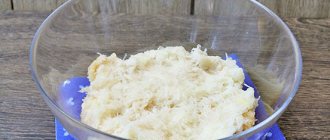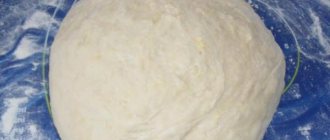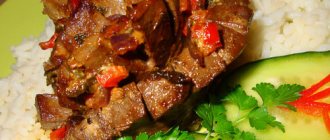Cooking tips
- Try to use fresh eggs for poaching, then the white will hold its shape better . To check freshness, place the egg in a container of water. A fresh egg will immediately fall to the bottom, while a stale egg will stand up with its blunt end up or begin to float. You can also shake the egg. Fresh ones are tightly attached to the shell, but stale ones will hang around inside.
- If you strain the egg through a slotted spoon or large sieve before cooking, you will not need to clean it of “rags.”
- To get the correct egg shape, you need to add a little vinegar to the water . This will not affect the taste of the egg, but it will help the whites gather more tightly around the yolk.
- During cooking, the water should not boil too much . It should simmer, and small bubbles will come from the bottom.
- The degree of poached cooking is checked by lightly pressing the yolk . When cooked correctly it will spring back. If the yolk is soft, it means it is undercooked, and if it is hard, it means it is overcooked.
Did you know? When going on a picnic to the hot springs, the Japanese often take eggs with them, which are cooked on the spot. The springs always maintain the ideal temperature for poaching – 60°.
Advanced
"A naturel"
The most seemingly simple and uncomplicated method is surrounded by many myths: add a couple of tablespoons of vinegar so that the white coagulates faster in an acidic environment, use a whisk to create a funnel so that the white flakes wrap around the yolk, first break the egg into a glass, and salt the water well. But in reality everything turned out to be much simpler.
Preparation: Boil a small amount of water, reduce heat to low. Add a couple of drops of vinegar. Take a small sieve and crack an egg into it, straining out the liquid white. Place the egg in barely simmering water and cook for 3.5 minutes.
CONCLUSION: The egg turned out almost perfect: I strained out the excess liquid protein, which turns into rags in water, using a sieve. (We spotted this trick from the great Heston Blumenthal). Adding vinegar is optional, and certainly not the key to perfect poaching. I added a couple of drops to make Moscow tap water, which is quite alkaline in composition, more neutral. It is better to use rice vinegar, then it will not affect the taste of the egg. If you place cooked eggs in cold water, they can be stored in the refrigerator for several days, warming them in hot water for about a minute before serving.
How to cook a poached egg at home
Kitchen utensils: small saucepan, small bowl, slotted spoon, spoon.
List of ingredients
| Egg | 1 PC. |
| Water | for cooking |
| Salt | optional |
Step-by-step preparation
- Pour water into a saucepan and bring it to a boil over high heat. I have a 1.5 liter saucepan for this. This is enough to boil several eggs in a row.
- Reduce the heat to the minimum and wait until the water stops boiling and bubbling heavily. If desired, add a little salt.
- Take a small bowl or small cup and crack an egg into it. We do this carefully so as not to damage the yolk.
If there is any doubt about the freshness of the egg, pour it onto a slotted spoon or sieve. Don't worry about all the squirrels escaping. Only its liquefied part will leave. Over time, the protein gradually loses its density and becomes watery. This causes peculiar rags to appear during cooking, which will then have to be removed.
- Using a spoon, stir the water clockwise and create a funnel.
- Take the container with the egg and pour it into the center of the funnel in one quick movement.
- We wait 2.5 minutes and remove the finished poached meat using a slotted spoon. It will take about the same amount of time to cook an egg in a pouch in its shell.
This poached dish is slightly flattened and fits perfectly on toast. It turns out to be a wonderful analogue of scrambled eggs in bread. If you need exactly the egg form, then add a couple of tablespoons of vinegar to the water after boiling.
Poached egg in the microwave
I usually cook scrambled eggs or an omelet. My husband loves them for breakfast, but one day I decided to experiment and cook the famous French poached egg, but do it in the microwave. We were completely delighted with this breakfast. The process turned out to be extremely simple and fast, you didn’t even have to turn on the stove, and the result was a delicate white combined with a spreadable yolk - it’s great!
Ingredients:
- chicken egg – 1 pc.;
- water – 100 ml;
- salt – 1 pinch.
How to poach an egg in the microwave
- In order to make it, we need only 3 ingredients - egg, water and salt.
- Pour a portion of water into a small deep plate (with a thick bottom so that it is suitable for a microwave oven). Dissolve a pinch of salt in it and carefully break the chicken egg so as not to damage the yolk. I prefer salt rather than vinegar (as many people advise), since salt does not impart a specific sour taste to the egg. Place the plate in the microwave. Set the time to 2 minutes and cook at maximum power until the microwave ends.
- After 2 minutes, it is worth checking for readiness - if the white has set, then you need to wait 20-30 seconds, then using a sieve or slotted spoon, carefully remove the egg from the bowl of water. When cooking for the first time, always check the cooking process, since how long to cook will directly depend on the power of the microwave oven, the utensils used and the amount of water. And in order to prepare more servings, you just need to increase the amount of water and salt, take a larger plate, and also increase the cooking time.
Just a few minutes and a delicious breakfast is ready!
I served it with toasted croutons and a fresh salad, I also added a few slices of hard cheese and a dollop of hot mustard for a little extra kick.
Author: Marina
Cooking options
How to cook a poached egg in the microwave
For many, the microwave has already become an indispensable assistant, especially for preparing quick breakfasts. For me personally, until recently, it had one drawback - you cannot boil eggs in it. They just explode there. But progress does not stand still, and I learned to cook poached eggs in it.
- To do this, place a suitable container of water in the microwave and bring to a boil. You can boil water in a kettle and pour it into the desired container.
- Take the egg and break it immediately into a container of boiling water.
- Place the bowl with the egg in the microwave.
- Turn on maximum power for 45-55 seconds.
- All. All that remains is to remove the egg from the water.
You can boil hard-boiled eggs in the same way, but it will take a little longer. You can also cook scrambled eggs in the microwave.
Poached egg in cling film
An egg prepared in this way is neatly shaped and resembles a pouch or manti. To do this, you will need a piece of cling film and a teaspoon of vegetable or olive oil. You can also boil a poached egg in a bag. This method is also convenient because you can cook several poached eggs at the same time, as well as embellish the taste of the egg with your favorite spices.
- Bring water to a boil in a saucepan or small saucepan and reduce heat.
- While the water is boiling, cut off the film and place it in a bowl or wide cup. Pour in the oil and spread it over the surface of the film using a brush.
If this is not done, then it will be difficult to separate the egg from the film.
- Break the egg and pour it onto the film. You can sprinkle the oil with pepper, a mixture of herbs or other spices before doing this.
- We collect the film in the form of a bag, wrap it and tie it. We try to remove all the air from the bag, then the egg will turn out to be neatly shaped.
- Place the egg in a saucepan with boiling water for 2.5-3 minutes.
- Remove using a slotted spoon and remove the film.
If you like scrambled eggs with cheese, you can sprinkle a little grated cheese on the film with butter before pouring it in.
How and how long to cook a poached egg
Poached egg means “egg in a pocket”, and that’s exactly how it turns out. The role of the pocket is played by the white, and its filling is the yolk.
Required Products:
- Egg – 1 pc.;
- water – 2 l.;
- vinegar - 2 tbsp. l.;
- salt to your taste.
Preparation:
Place a pan of water on the fire and wait until it boils. Then reduce the heat so that the water does not boil. Pour in the vinegar; it will help the whites coagulate around the yolk.
Break the egg into a sieve, and then carefully pour the egg into the water. A sieve is necessary so that the liquid protein drains and “rags” do not form around the egg during cooking.
How long to cook depends on your preference. According to the classics, such an egg needs to be boiled for 3.5 minutes. Then the yolk will acquire the desired texture. But if you like a thicker yolk, boil it a minute longer; you won’t spoil the dish.
After 3.5 minutes, carefully remove the egg with a slotted spoon and immerse it in cold water. This will stop the plowing process and wash away the vinegar. Salt the already prepared egg.
Good to know! There is no need to salt the water before cooking. Because of the salt, the protein coagulation process will be disrupted and everything will not go so smoothly.
What to serve with
There are no special rules for serving poached eggs. It depends on taste preferences and imagination. I offer several options that you can modify at your discretion:
- Place torn lettuce leaves on a plate. Cut cherry tomatoes in half or chop a regular tomato. Sprinkle everything with lemon juice and add poached meat. You can replace the salad with arugula or use it all together.
- Toast the toast and put the egg on it. You can, if desired, spread the toast with any sauce.
- You can make a sandwich. Take some toast and put lettuce and a slab of ham and cheese on it. Place poached meat on top. Instead of ham, you can take bacon, boiled pork, mushrooms and even seafood.
- Take some asparagus and fry it. Transfer it to a plate and place an egg on top.
- It can also be served with pasta, mashed potatoes or any vegetable side dish.
Step by step cooking recipe.
Preparation:
Take 1 toast bread, trim the edges (crusts)
Rinse the arugula and cherry tomatoes.
Cut the tomatoes into 2 halves.
Manufacturing.
Pour water into the pan and put it on fire, you want the water to almost boil, not boil, this is approximately 90 degrees.
While the water is boiling, fry the toast in a frying pan on both sides until golden brown.
The bread remains soft on the inside and crispy on the outside.
Once the water has warmed up, add salt, use a spoon to make a funnel in the water (this is necessary so that the egg can gather into a bag) and break the egg into it, holding your hands directly above the water.
Cook for three and a half minutes.
During cooking, make sure that the water does not start to boil.
Once the egg is cooked, take it out with a slotted spoon and place it on napkins to remove excess water.
Place the toast on a plate, top it with a poached egg, arugula and cherry tomatoes, like a light salad
Before breakfast, don’t forget to drink a glass of water.
Video recipe: how to cook a poached egg
Watch the original way to cook scrambled eggs for breakfast in the video, which shows how to cook a poached egg.
On our website you will find other ways to cook scrambled eggs. For example, you can cook it with tomatoes and other vegetables, or fry eggs and bacon.
Don't forget to leave your comments in which you can write a review of the recipe or your own methods for preparing poached eggs. Enjoy your meal!
How to serve a poached egg
- Poached eggs are most often served on plain or buttered toast. Salt, pepper and hot sauce are great accompaniments, as are salsas and chutneys of all kinds.
- For a slightly more elegant presentation, melt the butter in a frying pan, add some chopped herbs and add poached eggs to heat through. Serve immediately.
- Poached eggs also make a flavorful, protein-rich addition to soups and stews. They can also turn a simple salad into a dish, like the classic French bistro favorite frisee, salad with shallot vinaigrette and a poached egg on top.











